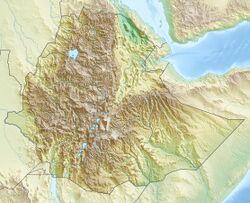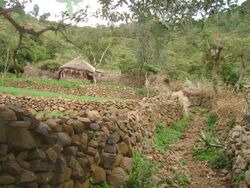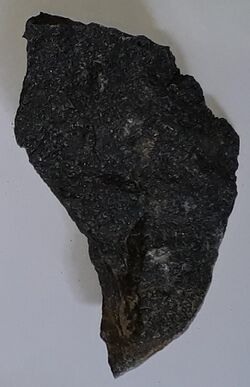Earth:Ashangi Basalts
| Ashangi Basalts Stratigraphic range: Oligocene | |
|---|---|
 West of Kerene Dogu'a Tembien) | |
| Type | Geological formation |
| Underlies | Alaji Basalts, Intra-volcanic sedimentary rock |
| Overlies | Amba Aradam Formation |
| Lithology | |
| Primary | Porphyritic Basalt |
| Location | |
| Coordinates | [ ⚑ ] : 12°34′56″N 39°31′11″E / 12.5823°N 39.51984986°E |
| Paleocoordinates | [ ⚑ ] 0°N 0°E / 0°N 0°E |
| Region | Tigray |
| Country | |
| Extent | Northern Ethiopian Highlands |
| Type section | |
| Named for | Lake Hashenge |
| Named by | William Thomas Blanford |
The Ashangi Basalts are the earliest Tertiary volcanic rocks in north Ethiopia, hence they are in the lowest position. These dark porphyritic basalts are separated from the Mesozoic formations below it by basal conglomerates. The basalts hold phenocrysts that developed before the magma reached the earth surface. These basalts are weathered, partially eroded and have a sub-horizontal stratification, particularly at the lower part. This series was created during the first period of the flood basalt eruptions in north Ethiopia, in the Oligocene.[1][2][3]
Name and definition
The name was coined by geologist William Thomas Blanford, who accompanied the British Expedition to Abyssinia in 1868,[4] after Lake Hashenge in Tigray, which is surrounded by large outcrops of the formation. So far the nomenclature has not been proposed for recognition to the International Commission on Stratigraphy.
Stratigraphic context
The formation covers Mesozoic sedimentary rocks, particularly Amba Aradam Formation and Adigrat Sandstone. In many places, on its upper side, deposits of intra-volcanic sedimentary rock occur.
Environment
These volcanic rocks formed through melting of Earth's mantle. After magma generation, lava flowed out over the surface, in successive flows. Some part of it disappeared within the next 1 to 3 million years due to weathering and erosion, while other parts remained present. Within the basalt, columnar joints occur as a result of cooling; they are visible along the flanks of the ridges. The columnar joints are perpendicular to the surface of the lava flows; they are mostly vertical, but may also be strongly inclined. The lower succession, the one that overlies the Amba Aradam Formation and the Adigrat Sandstone holds vertical and closely spaced columnar joints. A common characteristic of the columnar joints observed in the Ashangi Basalts is their pentagonal or hexagonal shape (in plan view).[2]
Lithology
The Ashangi Basalts are made of coarse-grained plagioclase minerals, surrounded by a matrix of fine-grained plagioclases and pyroxenes; some iron oxides are also present.[2]
Geographical extent
The Ashangi formation occurs widely in Tigray Region, including the May Ch'ew area and Dogu’a Tembien.[2][3]
References
- ↑ Justin-Visentin, E. (1974). "Petrografia, chimismo e petrogenesi dei corpi subvulcanici di Macallè (Tigrai Etiopia)". Memorie dell'Istituto di Geologia e Mineralogia, Universita di Padova 31: 1–33.
- ↑ 2.0 2.1 2.2 2.3 Miruts Hagos and colleagues (2019). The volcanic rock cover of the Dogu'a Tembien massif. In: Geo-Trekking in Ethiopia's Tropical Mountains, the Dogu'a Tembien District.. SpringerNature. ISBN 978-3-030-04954-6. https://www.springer.com/gp/book/9783030049546.
- ↑ 3.0 3.1 Hofmann, C. and colleagues (1997). "Timing of the Ethiopian flood basalt event and implications for plume birth and environmental change". Nature 389: 838–841. doi:10.1038/39853.
- ↑ Blanford, W.T. (1870). Observations on the geology and zoology of Abyssinia, made during the progress of the British expedition to that country in 1867-68. London: Macmillan and Co.. https://archive.org/details/cu31924024736666.
 |




